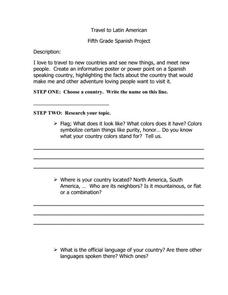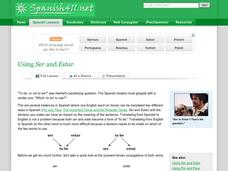1-2-3 Learn Curriculum
Colors in Spanish
How do you teach your pupils the colors? This activity requires kids to match colored strips to color words that are written in both English and Spanish. A fun hands-on twist to the typical color activity.
Curated OER
French Numbers Printable Worksheet
Un, deux, trois... soixante-dix mil! Practice French numbers from one on up with a basic activity. Pupils match numbers, count by tens, and try out the thousands, millions, and trillions.
Pimsleur
Book Report: Children Return to Their Roots
Based on the book Victoria Goes to Brazil (Children Return to their Roots) by Maria de Fatima Campos, this lesson plan will teach learners about family, geography, sports, music, and transportation. Learners read, summarize, and use the...
Pimsleur
Food and Drink
Talk about healthy lifestyle choices... in Italian! Class members categorize food cutouts into a food pyramid and discuss why some items are healthier than others. The plan offers additional vocabulary reinforcement ideas for younger as...
TV411
How Many Languages Do You Speak When You Speak English?
What do the words pizza, broccoli, and ciao have in common? Why they are all English words that originally came from Italian. Ask your middle schoolers to guess the origins of a list of words by matching the word with the language from...
Curated OER
Spanish Video Project - Me Gusta…
Find out what your Spanish pupils like and dislike with an oral presentation in the form of a video, poster, or PowerPoint. The assignment page provides requirements for the project in paragraph and checklist format. Pairs can use the...
Rocklin Unified School District
Spanish Speaking Countries Project
Ask your class members to provide a tour of a Spanish speaking country with a brochure and flag project. Learners research their assigned country, making sure to check off each of the required pieces of information listed on the first...
Allamuchy Township School District
Fifth Grade Spanish Project
Pupils can learn all about a Latin American country by following three simple steps. First, choose a country. Second, use the questions provided here to research that country. Third, create a poster or presentation that meets certain...
Curated OER
The Passive Voice in Spanish
The passive voice was mastered by Spanish learners. Your class members can find out all about how to create the passive voice in Spanish using ser, past participles, por, and the impersonal se. Examples are provided for each situation.
Curated OER
Relative Pronouns in Spanish
After reading up on relative pronouns and antecedents, Spanish learners can use the menu to navigate the material on the webpage. Each pronoun is paired with an explanation and examples. Within the provided presentation, you will find...
Curated OER
The Present Subjunctive: When?
Some Spanish learners believe the subjunctive is frightening. Help eradicate that fear by going into depth on when to use the present subjunctive. There are many different situations in which the subjunctive is used described here. You...
Curated OER
The Imperfect (Past) Subjunctive: When?
Is your class in the mood for the imperfect subjunctive? They will be if they understand when to use it. Pupils can read, or you can take lesson inspiration from, the the provided information. Learners will find out all about using the...
Curated OER
Online Spanish Lesson on Superlatives: General Rules
How much does your class know about superlatives? Inform them of the basics and provide some practice with the information here. You can use the examples to help teach the concepts in class or send learners to this page at home. The...
Curated OER
The Present Tense (Part 2)
When working with Spanish verbs in the present tense, learners will find that there are many irregular verbs and spelling changes that need to be made. This resource provides information on yo from spelling changes, strange stem changes,...
Curated OER
Spanish Parts of Speech (Part 2)
Zoom in on a few parts of speech to strengthen and deepen understanding. Pupils examine nouns, articles, adjectives, and conjunctions in closer detail, looking at more complex grammatical situations. In addition to the informational page...
Curated OER
Spanish Prepositional Pronouns
There are many different types of pronouns used in Spanish for various purposes. If your class has mastered subject pronouns, object pronouns, and reflexive pronouns, perhaps they are ready to learn about prepositional pronouns. You can...
Curated OER
Past Participles
Consider this online resource that includes accurate information about past participles for a reference material for your Spanish language, or as a source of inspiration for your own lesson. Beginning with a definition of past...
Curated OER
Negative Words & Expressions in Spanish
You don't never use double negatives in English, but the grammar is slightly different in Spanish. Help your class grasp this concepts and pick up how to compose sentences that are negative, rather than affirmative with the information...
Curated OER
Time Expressions with Hacer
The verb hacer has many purposes in the Spanish language, one of which is as part of time expressions. Your class can learn how to use hacer in the preterite, present perfect continuous, and past perfect continuous to express different...
Curated OER
Spanish Parts of Speech (Part 1)
Check out this overview of the parts of speech that includes English and Spanish examples. Each part of speech is highlighted in a different color for clarity. There is information on each part of speech here, and you or your pupils can...
Curated OER
Conjugating Verbs in Spanish
It's time to conjugate! If your class doesn't really know what that means, use the materials provided here to build understanding. The resource covers verbs, infinitives, the different Spanish verb endings, conjugation in the present...
Curated OER
Using Ser and Estar
While ser and estar both mean to be, they are each used in different situations. This is often confusing for Spanish language learners. Clarify these verbs for your class with direct instruction. The information included on this page...
Curated OER
Using Gustar
Expressing that you like something in English is quite different from expressing that you like something in Spanish. Clarify gustar for your class with the information included here. Pupils can read the information on the webpage to find...
Curated OER
The Personal a
Introduce your Spanish class to the personal a, used when the direct object is a person or personified thing. You can show the provided presentation first and direct them to the other two tabs on this webpage for reference and additional...

























